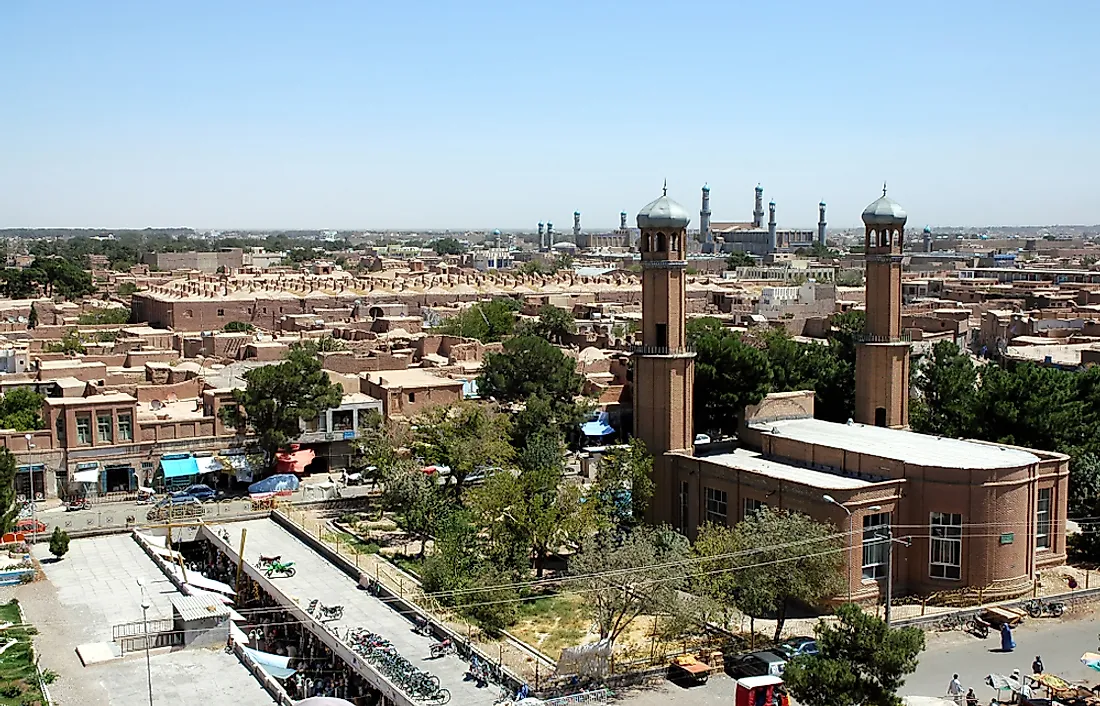Biggest Cities In Afghanistan

Afghanistan is a country in Central Asia covering an area of 652,230 square kilometers, housing a population of 32,564,342 people according to 2015 figures. Kabul is both the capital and the largest city in Afghanistan. The city developed along the banks of River Kabul to become the most influential and modern city in the country. The following is a list of the biggest cities in Afghanistan, with data from the 2015 Afghan Cities Report by the United Nations.
Kabul - 2,970,713
Kabul has a population of 2,970,713, although this is a low estimate. The city may have a population of upwards of 4 million individuals. Dari, a form of Afghan Persian, is the formal language. As the capital city, the country’s cultural and economic activities center on Kabul. In the last decade, Kabul’s economy has tracked its way up to being the fifth fastest growing economy in the world. Kabul dates back to the 2nd Century CE. The prime city location along the trade routes of central and south Asia has contributed a great deal to its prominence. Kabul became a local seat of the government as early as the 8th Century.
Herat - 673,425
The ancient city of Herat has a population of around 673,425. According to the National Demographics of 2003, 85% of these residents are Tajiks, 10% are Pashtu, 2% are Hazaras, 2% are Uzbeks, and 1% are Turkmen. Persian is the lingua franca, the native language, and the local dialect of Herat. Pashto is the second most widely spoken language. Sunni Muslims are the majority. The history of Herat dates back to Avestan times as wine producing city. It became the Pearl of Khorasan in the middle ages. The Hotaki forces invaded the city in 1717, but the Afsharids drove them out in 1736. The Soviet War also had a significant impact on the city.
Mazar-i-Sharif - 582,113
Mazar-i-Sharif is the third largest city in Afghanistan. It had a population of around 582,113 in 2015. The city is multilingual and multicultural. The Dari language dominates among the city dwellers, Uzbeki and Pashto are also the largest groups. Most of the people are Sunni Muslims. According to the National Demographics in 2013, 60% are Tajiks, 10% Hazaras, 10% Pashtu, 10% Turkmen, and 10% Uzbeks. Occasion ethnic violence has been reported between the Pashtuns and other ethnic groups. Mazar is the trading center in the northern parts of the country. Trade, agriculture, and the Karakul sheep farming dominate the local economy. There are also small-scale gas and oil companies contributing to the economy.
Kandahar - 464,265
Kandahar, the fourth-largest Afghanistan city, has a population of 464,265. Pashtun make up 70% of the people there, while 20% are Tajiks, 6% are Hazaras, 2% are Balochis, and 2% are Uzbeks. As a result, the city forms the major cultural center of the Pashtun people. Pashtun is the official language and Persian is spoken among government official and the educated. Alexander the Great founded the city in 329 BC around the ancient town of Arachosian. The strategic city location along the trading routes from Herat to Central Asia, to Kabul and India, has made Kandahar a prominent city. In 1747, the city became the first capital of a united Afghanistan. In the Afghan war, it became the center of the Afghan rebels fighting the Soviet invasion forces.
Biggest Cities In Afghanistan
| Rank | City | Population (Estimated) |
|---|---|---|
| 1 | Kabul | 2,970,713 |
| 2 | Herat | 673,425 |
| 3 | Mazar-i-Sharif | 582,113 |
| 4 | Kandahar | 464,265 |
| 5 | Jalalabad | 296,895 |











